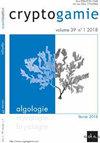Ericaria giacconei sp. nov. (Sargassaceae, Fucophyceae), the Species to which the Invalidly Published Cystoseira hyblaea Giaccone should be Referred
IF 1.5
4区 生物学
Q3 MARINE & FRESHWATER BIOLOGY
引用次数: 2
Abstract
ABSTRACT In this paper, a new species of the Cystoseira complex from Porto Palo di Capo Passero (Sicily, Italy) is described. The species, which shows the same characters as Cystoseira hyblaea Giaccone as described by Giaccone (1986) and Bouafif et al. (2016), from its morpho-anatomical characters, is assigned to the genus Ericaria Stackhouse. Because of “Cystoseira hyblaea” was not validly published name, Ericaria giacconei sp. nov. is here described. The main characteristics of the species are: 1) a caespitose habit; 2) large axes rugged with apices smooth, not prominent; 3) vegetative branches without spinose appendages; 4) primary branches with a cupressoid outline, especially when they are fertile; and 5) receptacles terminal, compact, cylindrical-oval, verrucose, with deciduous spinose appendages. Ericaria giacconei sp. nov. is related to both E. crinita (Duby) Molinari & Guiry and E. barbatula (Kützing) Molinari & Guiry, but it differs from them mainly in the basal system consisting of a robust and compact basal disc and in apex of cauloids smooth and not prominent, never surrounded by spiniform appendages. A critical re-examination of herbarium specimens from Isola delle Correnti (eastern Sicily, Italy) attributed to E. crinita (as C. crinita) demonstrated that they actually belong to our new species.(马尾藻科,岩藻科)——无效发表的杂囊藻属Giaccone应参照的物种
本文报道了意大利西西里岛波尔图帕洛阿尔迪卡波帕塞拉(Porto Palo di Capo Passero)的Cystoseira复合体的一个新种。该种与Giaccone(1986)和Bouafif et al.(2016)描述的Cystoseira hyblaea Giaccone具有相同的形态解剖特征,归属于erica Stackhouse属。由于“杂胞囊孢菌”没有被有效发表的名称,在这里描述的是紫锥虫。该物种的主要特征是:1)有寄生习性;2)大轴粗犷,顶端光滑,不突出;3)无刺附属物的营养枝;4)具有柏木状轮廓的初级枝,特别是当它们肥沃时;5)花托顶生,紧密,圆筒状卵圆形,疣状,具落叶刺附属物。giacconei p. 11 .与E. criinita (Duby) Molinari & Guiry和E. barbatula (k tzing) Molinari & Guiry有亲缘关系,但与它们的不同之处主要在于基部系统由结实紧凑的基盘组成,茎尖光滑但不突出,从不被棘状附属物包围。在意大利西西里岛东部的Isola delle Correnti (Isola delle Correnti, Italy)发现的植物标本被鉴定为E. criinita(被称为C. criinita),这表明它们实际上属于我们的新种。
本文章由计算机程序翻译,如有差异,请以英文原文为准。
求助全文
约1分钟内获得全文
求助全文
来源期刊

Cryptogamie Algologie
生物-海洋与淡水生物学
CiteScore
2.60
自引率
7.70%
发文量
11
审稿时长
>12 weeks
期刊介绍:
Cryptogamie is a fast-track and peer-reviewed journal of international scope publishing in English only. It accepts original papers and review articles on the taxonomy, biology and ecology of all cryptogams. An issue of Cryptogamie may be devoted to a single topic, under the responsibility of guest editor(s). All articles published in Cryptogamie are compliant with the different nomenclatural codes. A copyright assignment will be signed by the authors before publication.
Cryptogamie, Algologie accepts articles on systematics as well as ecology and evolution of any kind of algae (including Cyanobacteria).
 求助内容:
求助内容: 应助结果提醒方式:
应助结果提醒方式:


